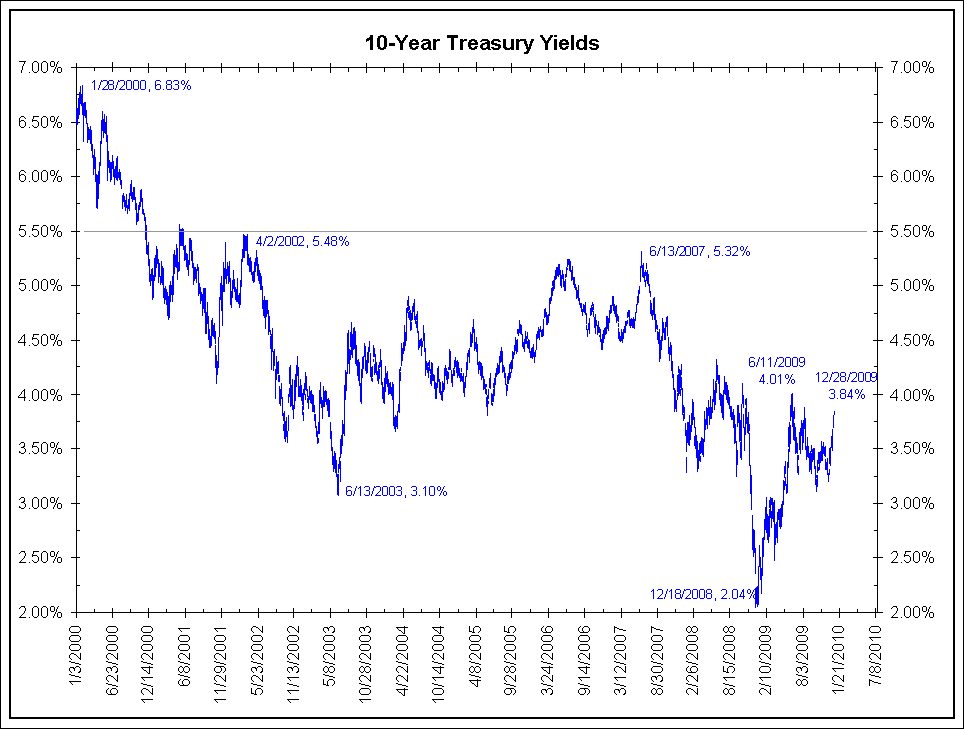What Would Cause A 5.50% 10-Year Note Next Year?
- Bloomberg.com – Morgan Stanley Sees 5.5% Note as U.S. Faces Deficits
If Morgan Stanley is right, the best sale of U.S. Treasuries for 2010 may be the short sale.
Yields on benchmark 10-year notes will climb about 40 percent to 5.5 percent, the biggest annual increase since 1999, according to David Greenlaw, chief fixed-income economist at Morgan Stanley in New York. The surge will push interest rates on 30-year fixed mortgages to 7.5 percent to 8 percent, almost the highest in a decade, Greenlaw said.Investors are demanding higher returns on government debt, boosting rates this month by the most since January, on concern President Barack Obama’s attempt to revive economic growth with record spending will keep the deficit at $1 trillion. Rising borrowing costs risk jeopardizing a recovery from a plunge in the residential mortgage market that led to the worst global recession in six decades. “When you take these kinds of aggressive policy actions to prevent a depression, you have to clean up after yourself,” Greenlaw said in a telephone interview. “Market signals will ultimately spur some policy action but I’m not naive enough to think it will be a very pleasant environment.”Yields on the 3.375 percent notes maturing in November 2019 climbed 4 basis points to 3.84 percent at 11 a.m. in London today, according to BGCantor Market Data. The price fell 10/32 to 96 5/32. They have risen 65 basis points this month, the most since April 2004, as government efforts to unfreeze global credit markets lessened the appeal of the securities as a haven. … Edward McKelvey, senior economist in New York at Goldman Sachs Group Inc., the top-ranked U.S. economic forecasters in 2009, according to data compiled by Bloomberg, expects yields to drop to 3.25 percent. Goldman Sachs says unemployment will average 10.3 percent in 2010, hindering the recovery.
Comment
The story above says a 5.50% 10-year yield would be the “the biggest annual increase since 1999, according to David Greenlaw, chief fixed-income economist at Morgan Stanley in New York.“ We are not sure what he means by this. If he means a rise in yields from 3.84% (current) to 5.50% would be a 166 (basis points) bps rise in yields, the largest since 1999, technically he is correct. However, the 10-year started the year at 2.24% and has risen 160 bps already year-to-date. Should the 10-year yield rise another three bps this week, then a rise to 5.50% next year would be smaller than this year’s increase in yields. Morgan Stanley is trying to get our attention with an eye-popping statistic to get the point across that next year will be a bad year for Treasury market investors.
We bring this up not to be picky, but to point out that 2009 is going to be long-term Treasury securities’ worst total return year ever. Year-to-date (YTD) the 10-year is down 10.2% (the 30-year is down an incredible 24% YTD). These are by far the worst total returns ever seen in the fixed-income market for one year. Reliable data started in 1927.
If Morgan Stanley is trying to say that 2010 will be a disaster for Treasury investors, here is some news for them, 2009 was a disaster in proportions never before seen. So, are they looking at what has happened and projecting that it will happen again?
What Do We Think?
The chart below shows the last decade of 10-year yields. A move to 5.50% (gray horizontal line) would be near a 10-year high.
<Click on chart for larger image>
We believe that such a move is entirely possible on the back of runaway inflation fears. The next chart below shows TIPS 10-year inflation breakeven levels. Note that in recent weeks inflation expectations have been going vertical and are now at 2.40%.
<Click on chart for larger image>
Inflation expectations are up almost 250 bps since the start of the year, far more than the 160 bps rise in nominal 10-year yields. Should 10-year yields go to 5.50% by the end of next year, we would expect it to be accompanied by a huge rise in inflation expectations. Back-of-the-envelope calculations would put the 10-year inflation breakeven rate near 4.00%, an all-time high (its current record high, which is not shown above, was 3.32% set the week after TIPS were first introduced in February 1997).
In other words, a rise to 5.50% would mean that TIME’s Person of the Year (Bernanke) was an utter failure in 2010, as is often the case the year after one is awarded POY. The exit strategy will have been botched and the world will be close to hyperventilating about inflation coming back. Julian Robertson’s prediction of 20% inflation will not look so laughable anymore.
This scenario is certainly possible if the Federal Reserve continues to flood the market with easy money, thus fueling inflation fears. In other words, this can happen if the Federal Reserve continues to botch the exit strategy (not botching the exit strategy means to withdraw the excess liquidity before heightened inflation expectations take hold and without causing financial market instability) . Higher inflation is something we have frequently worried about and we believe is the foundation of Morgan Stanley’s forecast.
Of course Morgan Stanley cannot say this out loud because they need access to the Federal Reserve. The Fed comes down very hard on mainstream forecasters that say anything bad about them.




What's been said:
Discussions found on the web: